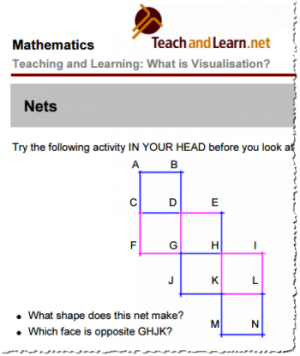Using visualisation in maths teaching
About. This is an Open University web tutorial with exercises to explore and explain 'visualisation'. Imagery is a powerful force for perception and understanding. Being able to see something mentally is a common metaphor for understanding it. Visualising means summoning up a mental image of something. Some people can close their eyes and “see” a picture, but for others it has much more to do with imagining, than seeing. Try to picture a cube, the seven-times table, a graph of sin x. Now describe what you “see”...
Pedagogical content. This unit looks at visualisation(ta) as it relates to mathematics, focusing upon how it can be used to improve learning. It also identifies ways in which to make more use of visualisation within the classroom. (edit)
| Resource details | |
| Title | Using visualisation in maths teaching |
| Topic | [[Topics/Visualisation|Visualisation]] |
| Teaching approach | [[Teaching Approaches/Visualisation|Visualisation]] |
| Learning Objectives | The learning outcomes for this unit are to:
|
| Subject | [[Resources/Maths|Maths]] |
| Age of students / grade | [[Resources/Secondary|Secondary]], [[Resources/Primary|Primary]], [[Resources/Higher|Higher]] |
| Table of contents |
|
| Files and resources to view and download | Follow the link to a study unit with exercises as PDF documents
|


